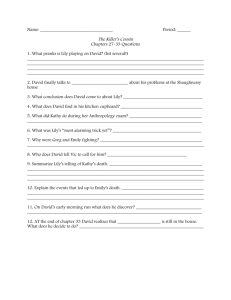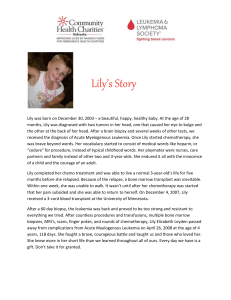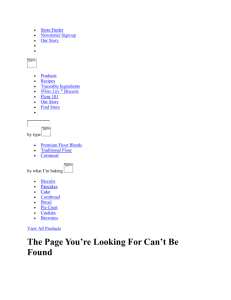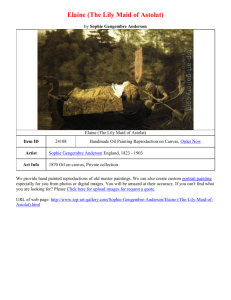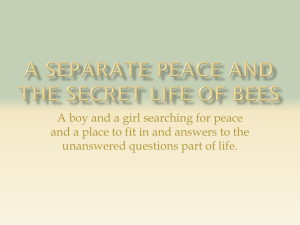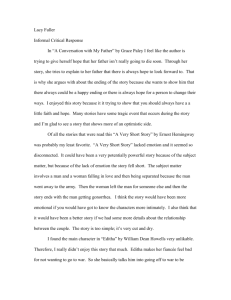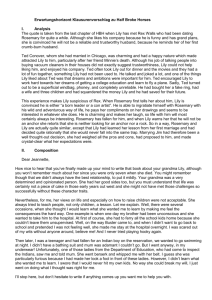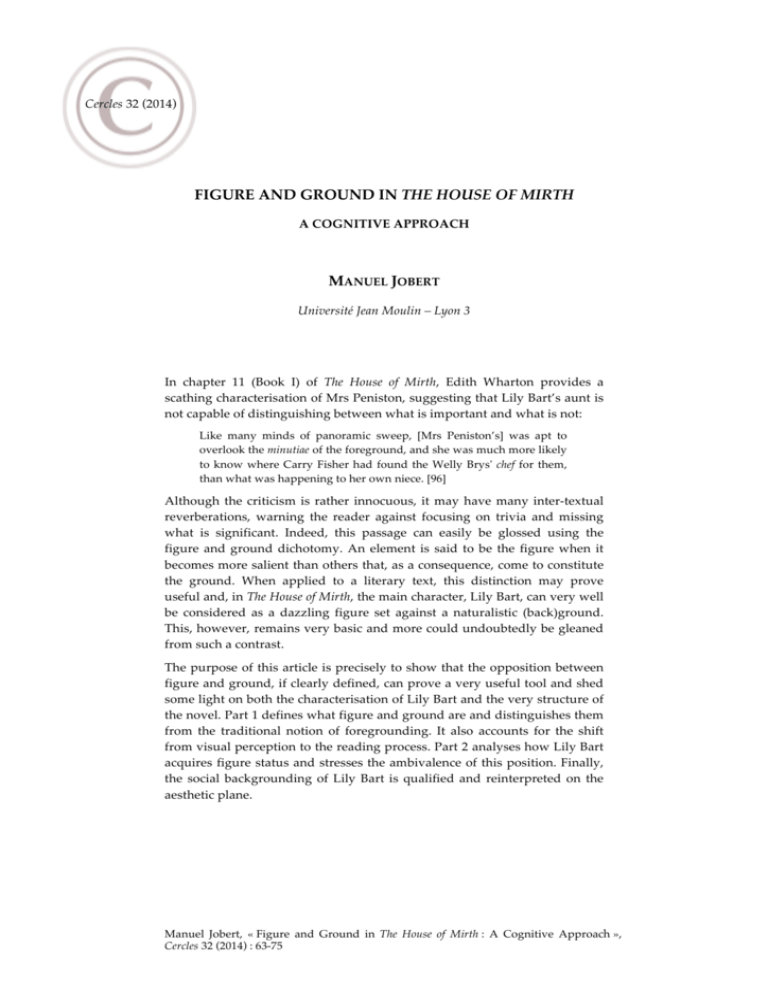
Cercles 32 (2014)
FIGURE AND GROUND IN THE HOUSE OF MIRTH A COGNITIVE APPROACH MANUEL JOBERT Université Jean Moulin – Lyon 3 In chapter 11 (Book I) of The House of Mirth, Edith Wharton provides a scathing characterisation of Mrs Peniston, suggesting that Lily Bart’s aunt is not capable of distinguishing between what is important and what is not: Like many minds of panoramic sweep, [Mrs Peniston’s] was apt to overlook the minutiae of the foreground, and she was much more likely to know where Carry Fisher had found the Welly Brys'ʹ chef for them, than what was happening to her own niece. [96] Although the criticism is rather innocuous, it may have many inter-­‐‑textual reverberations, warning the reader against focusing on trivia and missing what is significant. Indeed, this passage can easily be glossed using the figure and ground dichotomy. An element is said to be the figure when it becomes more salient than others that, as a consequence, come to constitute the ground. When applied to a literary text, this distinction may prove useful and, in The House of Mirth, the main character, Lily Bart, can very well be considered as a dazzling figure set against a naturalistic (back)ground. This, however, remains very basic and more could undoubtedly be gleaned from such a contrast. The purpose of this article is precisely to show that the opposition between figure and ground, if clearly defined, can prove a very useful tool and shed some light on both the characterisation of Lily Bart and the very structure of the novel. Part 1 defines what figure and ground are and distinguishes them from the traditional notion of foregrounding. It also accounts for the shift from visual perception to the reading process. Part 2 analyses how Lily Bart acquires figure status and stresses the ambivalence of this position. Finally, the social backgrounding of Lily Bart is qualified and reinterpreted on the aesthetic plane. Manuel Jobert, « Figure and Ground in The House of Mirth : A Cognitive Approach »,
Cercles 32 (2014) : 63-75
Manuel Jobert / 64
1. Figure v. ground and the literary text Figure and ground in the visual field The figure and ground opposition is derived from Gestalt psychology. It was developed at the beginning of the 20th century and was later introduced into cognitive linguistics and cognitive stylistics. Originally, the opposition between figure and ground was exclusively a visual one. As human beings, we see in 3-­‐‑D and we distinguish between objects located in the foreground and objects located farther away from us. In some cases, the contrast between figure and ground may be blurred and you can decide to foreground or background a particular feature at will: In this drawing, you can either see four mice reaching the centre of a circle or alternatively a cross in the middle of a circle with ornamental black dots. This is of course a visual trick and in most cases the distinction between figure and ground is clear even if we are not aware of it. Figure and ground v. foregrounding Applying this visual functioning of the brain to reading is often taken for granted but rarely explained fully.1 For instance, Stockwell draws a parallel between vision and the reading process: […] since figure and ground are differentiated on the basis of traits or features that we perceive in the objects in view, our orientation in the world fundamentally depends on our ability to perceive style and stylistic differences in objects. Figure and ground are therefore the basic features of literary stylistic analysis too. [STOCKWELL 2002 : 15] (my emphasis) At a very basic level, this capacity enables us to distinguish between the text from the white background of the page or between a title and the main text. 1
Manuel Jobert / 65
The causality suggested here would benefit from being fleshed out in more detail. Jeffries & McIntyre are slightly more explicit: It is relatively easy to see how the concept of figure and ground as employed in the visual arts may be extended by analogy to language, and how, in doing so, the notion of a figure equates to the linguistically foregrounded elements of texts. [JEFFRIES & MCINTYRE : 134] (my emphasis) However, the figure and ground opposition is equated with the more traditional notion of foregrounding. This term comes from the Czech “aktualisace” and was used by the Prague School of Linguistics to refer to “a deviation from the norm”. Leech defines it as follows: […] foregrounding is a deviation, or departure, from what is expected in the linguistic code or the social code expressed through language; functionally, it is a special effect or significance conveyed by the departure. [LEECH : 3] In other words, foregrounding is a defining feature of the poetic function of language. There is foregrounding when readers become aware of the linguistic code because of its unusual use. Metaphors or alliterations are regarded as prototypical examples of foregrounding. However, figure is not strictly speaking synonymous with foregrounding in the technical, textual sense although a certain amount of overlap exists. Indeed an object may very well become a figure even if language is used in a not unusual way.2 Langacker explains the nature of the analogy between vision and other domains of implementation: Many kinds of asymmetries lend themselves to metaphoric description as foreground vs. background. Though distinguishable, they can all be seen as manifesting a very general feature of cognition. Most broadly, they all involve departure from a base-­‐‑line, the exploitation of previous experience […] for the interpretation of subsequent experience. [LANGACKER : 58] (my emphasis) The definition of figure and ground is therefore looser than that of foregrounding. Nevertheless, it adds a cognitive dimension to the strictly textual sense of foregrounding by explaining how and why we are attracted by deviant features. If we consider Langacker’s definition, the figure and ground metaphor could be used for almost anything as a catch-­‐‑all device. As such, it loses its edge as well as its interpretative power. In this article, I will 2 Croft & Cruse give the following example: “Sheila [figure] went into the house [ground]”. [CROFT & CRUSE : 56] Manuel Jobert / 66
only be concerned with the visual dimension of the figure and ground dichotomy. To be complete, this study would imply some follow-­‐‑up work on different kinds of figure and ground contrast and even, to remain in the visual field, a systematic study of landscapes in the novel. Obviously, the film version of the novel could also be studied from this perspective. Figure and ground in the fictional field The first page of The House of Mirth provides a good entry-­‐‑point to explain how the gap between reality and fiction may be bridged in connection with figure and ground while justifying the metaphorical use of the terms. In the second sentence of the novel, Selden is established as the reflector of the scene: “[…] his eyes had been refreshed by the sight of Miss Lily Bart” [5]. The use of Free Indirect Style (FIS) reinforces him in his role: “[…] but what was Miss Bart doing in town at that season?” [5]. Mental process verbs (inferred, perplexed, knew) make him the centre of consciousness of the passage and the deictics (past her, She came forwar) establish him as the origo (i.e. the reference point on which the deictics are based) of the scene. Quite naturally, because Selden becomes the reflector, readers accept the convention of seeing the scene through his eyes. As a consequence, the fictional world created becomes an alternative world. In this newly-­‐‑formed textual world, the visual contrasts between figure and ground are similar to what readers experience daily, but they are once-­‐‑removed and mediated through language by the reflector. Quite aptly, in the same passage, Lily Bart is established as the figure in unambiguous terms: Selden had never seen her more radiant. Her vivid head, relieved against the dull tints of the crowd, made her more conspicuous than in a ball-­‐‑room, and under her dark hat and veil she regained the girlish smoothness, the purity of tint, that she was beginning to lose after eleven years of late hours and indefatigable dancing. [5-­‐‑6] (my emphasis) If we compare this passage to the list of features that Stockwell associates with figure, it seems that the first scene of the novel has been written to illustrate the theory: •
it will be regarded as a self-­‐‑contained object or feature in its own right, and with well-­‐‑defined edges separating it from the ground; •
it will be moving in relation to the static ground; •
it will precede the ground in time and space; •
it will be a part of the ground that has broken away, or emerges to become the figure; Manuel Jobert / 67
•
it will be more detailed, better focused, brighter, or more attractive than the rest of the field; •
it will be on top of, or in front of, or above, or larger than the rest of the field that is then the ground. [STOCKWELL 2002 : 15] The film version also relies on the figure and ground contrast for Lily’s arrival at Grand Central although some inter-­‐‑semiotic transpositions are apparent. The viewpoint is not that of Selden at the beginning but Lily Bart is literally presented as a “figure” or a silhouette emerging from a cloud of steam. In the film narrative, the atmosphere is more oppressing but the female character stands out. It is worth underscoring the fact that the figure and ground code is somewhat tampered with. For instance, Lily’s silhouette stands out because it is black against a whitish ground whereas usually, it is the other way round. On a more anecdotal note, Lily Bart is described as “a figure to arrest even the suburban traveller” [5] (my emphasis). The word figure is of course used in a non-­‐‑technical sense (i.e. a person’s bodily shape) but because of its various shades of meaning, it can also accommodate the technical sense of the word. In the novel, the word “figure” is used eight times in connection with Lily Bart.3 Each time, it specifies Lily’s social or psychological positioning. As the main character, it is only natural that Lily Bart should be the major figure of the novel. However, she is so almost to a point of saturation. In cognitive terms, this “’super-­‐‑foregrounded’ figure” [STOCKWELL 2002 : 14] is known as the “dominant”, a point of convergence between thematic and stylistic considerations. 2. “Miss Bart was a figure to arrest even the suburban traveller” [5] Figure and ground images The network of figure and ground images is particularly dense in Book I. These comments are never purely cosmetic and always have a specific functional / thematic role. Men succumbing to Lily’s charm are quick to notice her differences. Selden, the reflector of the passage, notices how “her drooping profile was outlined against the warm background of old bindings” [11] while Mr Gryce is similarly impressed: The software Antconc retrieved 30 occurrences of the word “figure”, 23 occurrences exhibiting its general meaning of physical shape. 3
Manuel Jobert / 68
When tea came he watched her in silent fascination while her hands flitted above the tray, looking miraculously fine and slender in contrast to the coarse china and lumpy bread. [18] (my emphasis) However, it not only her physical appearance that is at stake. Lily’s very identity is also based on the figure and ground dichotomy, caught, as she was, between “the vigorous and determined figure of a mother” [25] and “the hazy outline of a neutral-­‐‑tinted father” [25] that “she seemed always to have seen […] through a blur” [29]. She also feeds on other people’s perception of her: “Mrs Bry’s admiration was a mirror in which Lily’s self-­‐‑
complacency recovered its lost outline” [81]. As for the way she anticipates her future, the same tension is at work: The truth was, she had attended too many brides to the altar: when next seen there she meant to be the chief figure in the ceremony. [69] (my emphasis) This sense of conscious “figural triumph” reaches its climax in the opera episode, presented in FIS and suggesting a sense of overwhelming power: Ah, it was good to be young, to be radiant, to glow with the sense of slenderness, strength and elasticity, of well-­‐‑poised lines and happy tints, to feel one'ʹs self lifted to a height apart by that incommunicable grace which is the bodily counterpart of genius! [91] Yet, the omniscient narrator is prompt to spell out the hubristic implications of such self-­‐‑appreciation verging on imagined invulnerability: But brilliant young ladies, a little blinded by their own effulgence, are apt to forget that the modest satellite drowned in their light is still performing its own revolutions and generating heat at its own rate. [91] The keyword here is of course effulgence, a mixture of beauty and brightness, which could be used as a short-­‐‑hand to refer to Miss Bart. The dramatisation of figure and ground The text is actually denser than that. Not only does the figure and ground dichotomy appear in the guise of metaphoric language, but it is also dramatised. The tableaux vivants episode both highlights the phenomenon whilst putting it at a distance as its very artificiality is … foregrounded. This event occurs at the precise moment when Lily notices her popularity is beginning to flag. For her, it is an opportunity to quell criticism as well as to show herself (and others) she still possesses the necessary seductive power. The quality of the show is emphasised as each participant has been chosen with great care. The subjects perfectly play their parts and actually improve on the originals rather than just evoking them. Despite the exceptional Manuel Jobert / 69
quality of the evening, Lily manages to stand out. Here again, the words used unambiguously evoke the figure and ground dichotomy: Indeed, so skilfully had the personality of the actors been subdued to the scenes they figured in that even the least imaginative of the audience must have felt a thrill of contrast when the curtain suddenly parted on a picture which was simply and undisguisedly the portrait of Miss Bart. [106] (my emphasis) To achieve her goal in stage-­‐‑managing her performance, Lily Bart relies on sparseness and makes sure the background does not interfere with her natural beauty: It was as though she had stepped, not out of, but into, Reynolds'ʹs canvas, banishing the phantom of his dead beauty by the beams of her living grace. The impulse to show herself in a splendid setting […] had yielded to the truer instinct of trusting to her unassisted beauty, and she had purposely chosen a picture without distracting accessories of dress or surroundings. Her pale draperies, and the background of foliage against which she stood, served only to relieve the long dryad-­‐‑
like curves that swept upward from her poised foot to her lifted arm. [106] (my emphasis) The precision of the language (not out, but into) as well as the minute description of the effect point to the amount of staging involved. Somewhat paradoxically, Lily appears to Selden as she truly is, with no social mask: Its expression was now so vivid that for the first time he seemed to see before him the real Lily Bart, divested of the trivialities of her little world, and catching for a moment a note of that eternal harmony of which her beauty was a part. [106] Narrative viewpoint plays an essential role here. Lily’s subtle yet overwhelming perfection impresses everyone. Nevertheless, some are attracted by her apparent purity (Selden and Gerty) whilst others have more sexual or at least physical considerations in mind. The male comments reported by Selden point to Lily’s predicament, which he dubs the “tragedy of her life” [107]. Although she establishes herself as an unattainable figure, eclipsing her rivals and impressing New York society at large, she simultaneously debases herself as a piece of merchandise. This tension is at the heart of Lily Bart’s destiny. The dangers of being a figure The problem of female characters in Wharton’s novels is that they cannot remain in the background forever if they do not want to be reduced to mere spectators, like Gerty Farish, “content to look through the window at the Manuel Jobert / 70
banquet spread for her friends” [118]. Conversely, being a conspicuous figure may result in social repudiation. In Lily’s case, Mrs Dorset’s reaction precipitates the downfall of the heroine. This psychologically intricate episode can nevertheless be summarised concisely albeit rather crudely: Mrs Dorset sacrifices Lily Bart in order to save her reputation and her marriage. Both Selden and Lily are acutely aware of the potential danger but decide to ignore it. During the dinner preceding Lily’s eviction from the Dorset ship, Selden’s description of her could not be more positive. She appears as the ultimate figure to the point of suggesting she does not belong with this set of people and that she is bound to be severed from them: It was one of the days when she was so handsome that to be handsome was enough, and all the rest -­‐‑ her grace, her quickness, her social felicities -­‐‑ seemed the overflow of a bounteous nature. But what especially struck him was the way in which she detached herself, by a hundred undefinable shades, from the persons who most abounded in her own style. It was in just such company, the fine flower and complete expression of the state she aspired to, that the differences came out with special poignancy, her grace cheapening the other women'ʹs smartness as her finely-­‐‑discriminated silences made their chatter dull. [167-­‐‑8] (my emphasis) This laudatory presentation prepares the ground for the betrayal scene proper, which appears all the more brutal as the victim is an exceptional, almost surreal, specimen. The precise narrative comments that accompany her repudiation are similar to cold yet precise stage-­‐‑directions giving indications regarding space, gesture and voice, thus increasing readerly involvement. The wording of the social banishment is extremely sober: “’Miss Bart is not going back to the yacht,’ she said in a voice of singular distinctness” [169], followed by “’Miss Bart remains here,’ his wife rejoined incisively”. In these two laconic turns, the violence of the statements is conveyed by the paralinguistic register used (tone of voice), i.e. by the illocutionary rather than the locutionary act. All the participants instantly become aware of what is at stake. The commotion is total and the description is almost a caricature: Mrs Bry is on the verge of congestion; Mrs Stepney retreats behind her husband and Selden – usually a man of inaction – considers using physical violence to calm himself. As for Mr Dorset, he can only stammer his feeble protest. In contrast, Lily appears unmoved and in a state of extreme resilience: Miss Bart, during this brief exchange of words, remained in admirable erectness, slightly isolated from the embarrassed group about her. She had paled a little under the shock of the insult, but the discomposure of the surrounding faces was not reflected in her own. The faint disdain of Manuel Jobert / 71
her smile seemed to lift her high above her antagonist'ʹs reach, and it was not till she had given Mrs. Dorset the full measure of the distance between them that she turned and extended her hand to her hostess. [169-­‐‑170] At the height of adversity, Miss Bart remains an unblemished figure. Whereas before, her description was the result of subjective viewpoints (mostly Selden’s), it is the omniscient narrator’s voice that is heard this time, which adds to the authority of the characterisation. The contrast between Lily Bart and the other characters could not be signalled more clearly. It is in the heat of her social repudiation that she becomes a paragon of integrity and distinction as if she had been put on a pedestal only to be toppled over. While Book I is devoted to Lily’s accession to figure-­‐‑like status, Book II dramatises her inexorable fading away into the background. 3. The ground remains the figure Lily’s social grounding When Lily tells her aunt about her financial problems, the down-­‐‑to-­‐‑earth old lady comes up with a radical solution: Lily should stay with her for a few months instead of running around, spending money irresponsibly. This temporary grounding was prevented by Mrs Dorset’s invitation which led to a much more definitive grounding. Indeed, figures only exist inasmuch as they are perceived as objects of “attention”. Stockwell defines readerly attention as follows: Attention is selective rather than an undiscriminating blanket phenomenon. Certain elements in a visual field are selected for attention, and these will typically be the elements that are regarded as figures. This means that the ground of the visual field is deselected, or characterised by neglect. Cognitive psychologists have used the metaphor of the ‘spotlight’ as a means of understanding the focus of attention. [STOCKWELL 2002 : 18] However, it is precisely because she is relegated to the background of society that Lily Bart remains the focus of readerly attention. Backgrounding Lily socially results in making her more conspicuous to readers. Indeed, the events that accompany her social downfall are more intriguing than the previous husband-­‐‑hunting episodes. Although in Book I Lily Bart was both the heroine and the major figure, she remains the main character as well as the figure for readers but not for the other characters. The vantage point adopted by the narrative voice is more complex to assess. Lily Bart remains Manuel Jobert / 72
the main concern of the narrator but the images used are not of the same nature as in the first part, which creates a major distortion in terms of reception. Lily was used to being the main focus of attention and devoted most of her time trying to maintain her position. After the reading of Mrs Peniston’s will, Lily discovers that, disinherited as she is, she does not exist anymore socially and is spurned by her own family. Quite aptly, this is translated in the visual field: “No one looked at her, no one seemed aware of her presence; she was probing the very depths of insignificance” [174]. Whereas before, her identity partly depended on her image such as it was reflected in other people’s eyes, she is now hardly aware of being observed: One or two of these passers-­‐‑by slackened their pace to glance curiously at her lonely figure; but she was hardly conscious of their scrutiny. [242] As such, her often-­‐‑mentioned growing paleness only represents the first stage of her complete disappearance. Maritime metaphors take over and underscore the fact she is off her natural course: “Lily had the doomed sense of the castaway who has signalled in vain to fleeing sails” [179], or again “Lily herself remained without plan or purpose, stranded in a backwater of the great current of pleasure” [184]. The figure images are replaced by images of being off-­‐‑centre. She does not, strictly speaking, become the ground as she is still an autonomous entity (a “castaway” for instance) but is not centre stage anymore in the phrases relating to her. Her attempt to reconstruct a social life similar to her previous one and to come back to the forefront is doomed to failure as the oxymoronic expression indicates: “The Gormer milieu represented a social out-­‐‑skirt” [182] (my emphasis). Given that Edith Wharton spoke French fluently, the pun is necessarily an intentional one. Regaining her former place in society would imply several moral concessions that Lily is not ready to make. Using Bertha’s letters to avenge herself and, potentially, to marry either Dorset or Rosedale would imply tarnishing Selden’s reputation. As for her time at the service of Mrs Hatch, it is short-­‐‑lived. The figure and ground dichotomy is used again (from Lily’s perspective this time) but, for the first time, with negative overtones, implying she is no longer lured by such artificialities: Lily had not been long in this pallid world without discovering that Mrs Hatch was its most substantial figure. That lady, though still floating in the void, showed faint symptoms of developing an outline […]. [213] (my emphasis) Manuel Jobert / 73
Although Lily adapts to developing circumstances and takes a final moral stance, her physical degradation suggests she can’t survive such radical changes. What was true of her at the beginning of the novel has not changed: No; she was not made for mean and shabby surroundings, for the squalid compromises of poverty. Her being dilated in an atmosphere of luxury; it was the background she required, the only climate she could breathe in. [23] The description of the room where she boards, with its shroud-­‐‑like curtains, adds a sense of foreboding to Rosedale’s description. His disbelief is not the result of the discovery that such places exist but his incapacity to associate them with Miss Bart: He continued to scan the blistered brown stone front, the windows draped with discoloured lace, and the Pompeian decoration of the muddy vestibule. [229] Figure and ground reassessed It is precisely in this shabby décors that the novel ends as if to highlight the incongruity and the unnaturalness of Lily’s death. However, the final scene, during which Selden discovers Lily’s body, suggests a blurring of the distinction between figure and ground. When he enters the room, Selden notices the sunlight that “poured a tempered golden flood into the room” [252]. However, the light, poetically described as it may be, only gives glimpses of Lily’s body and does not offer a clear picture of the scene. Instead the overwhelming use of negative prefixes and suffixes (“motionless hands”, “unrecognising face” [252], “invisible”, “inaccessible”, “motionless sleeper” [253], my emphasis), as well as the neither … nor construction, seem to suggest the impossibility of grasping the reality of the situation such as it is. Even when he is close to her, Selden perceives “a delicate impalpable mask over the lineaments he had known” [253] as if direct access was forever impossible. The final episode is the culminating moment of the novel but, instead of being the main focus, Lily appears as a set of fragments (hands, face) and her immediate surroundings, the actual background, Spartan as they may be, absorb Selden’s as well as the reader’s attention. However, the two lovers have never been closer and their mutual understanding has never been so perfect. It is the very absence of life in Lily that is the actual figure of the passage but this figure cannot be described. It can only be accounted for in contrast with the ground whose materiality offers but little comfort to the disconsolate Selden. The word that “passed between them” [256] in this final moment could very well be the metonymy of this “absent figure”, all the more present as it is nowhere to be seen. Manuel Jobert / 74
* This study has shown that the figure and ground dichotomy is a precious tool to analyse the evolution of Lily Bart and, as a consequence, the main structure of the plot. Although main characters are usually figures, in Book I, this quality is firmly established. Because of her trajectory, and the language used to characterise her, Lily becomes an archetypal figure. In Book II, her downfall is incompatible with figure status but she remains the major topic. This apparent contradiction is resolved in the last chapter which shifts the focus from the figure onto the ground only to highlight the value of the lost figure. In a novel in which appearances matter so much, the tension which is established and maintained between figure and ground should not be underestimated. Choosing this particular tool turned out to be productive precisely because it accommodates both the themes developed in the novel and the language used by the author. Edith Wharton’s style is very complex and subtle and should be patiently scrutinised in order to gain access to its various layers of meaning, its very texture.4 Bibliography CROFT, W. & D.A. CRUSE. Cognitive Linguistics. Cambridge: University Press, 2004. JEFFRIES, L. & D. MCINTYRE. Stylistics. Cambridge: University Press, 2010. LANGACKER, R. Cognitive Grammar : A Basic Introduction. Oxford: University Press, 2008. LEECH, G. Language in Literature : Style and Foregrounding. Harlow: Pearson-­‐‑
Longman, 2008. STOCKWELL, P. Cognitive Poetics : An Introduction. London: Routledge, 2002. “Readings consist of the interaction of texts and humans. Humans are comprised of minds, bodies and shared experiences. Texts are the objects produced by people drawing on these resources. Textuality is the outcome of the workings of shared cognitive mechanics, evident in texts and readings. Texture is the experienced quality of textuality”. [STOCKWELL 2009 : 1] 4
Manuel Jobert / 75
STOCKWELL, P. Texture : A Cognitive Aesthetic of Reading. Edinburgh: University Press, 2009. WHARTON, Edith. The House of Mirth (1905). New York & London: W.W. Norton & Company, 1990.

